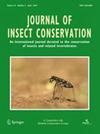What’s in the bee nest holes? A single aggregation of Megachile parietina reveals and helps to fill up Eltonian shortfalls
IF 1.9
3区 农林科学
Q2 ENTOMOLOGY
引用次数: 1
Abstract
Abstract Megachile (Chalicodoma) parietina (Geoffroy, 1785) is a Palearctic solitary bee included in the Red List of some central European Countries. Females build durable nests, reused year after year, by mixing soil with a salivary secretion. Like for most solitary bees, the resources contained within M. parietina nests attract several other insects which exploit pollen supplies or feed on the immature brood. These associated insects have mainly been studied for mantained bees and considered for their effect on the host reproductive success. A very large nesting aggregation of M. parietina in Central Tuscany has been studied for three consecutive years. We have identified 32 associated insect species, which certainly are an underestimate of the species present. Among the identified species, only eight had been previously reported for M. parietina . All the species were classified both according to the specificity for the host taxon ( Chalicodoma , Megachilidae, Anthophila, Hymenoptera, Others) and to the ecological relationship (cleptoparasites, parasitoids, predators of larvae, food commensal, scavengers, and occasional nest users). This highlighted both the richness of the ecological network within the nesting aggregation and the value of studying these nesting sites to fill Eltonian shortfalls, i.e. the deficiency in ecology knowledge, of bees and their associated fauna. Implications for insect conservation. We suggest that, besides their role in pollination, large and stable bee nesting sites increase the local insect biodiversity, and that attention should be paid to their conservation within actions aimed to support populations of wild pollinators.蜂窝洞里有什么?Megachile parietina的单一集合揭示并帮助填补了埃尔顿理论的不足
摘要巨蜂(Megachile (Chalicodoma) parietina (Geoffroy, 1785)是一种被列入一些中欧国家红色名录的古北独居蜜蜂。雌性通过混合土壤和唾液分泌物来建造耐用的巢穴,年复一年地重复使用。像大多数独居蜜蜂一样,巢中所含的资源吸引了其他一些昆虫,它们利用花粉供应或以未成熟的幼虫为食。这些相关昆虫主要是针对养蜂进行的研究,并考虑到它们对寄主繁殖成功的影响。连续三年研究了托斯卡纳中部一个非常大的parietina巢群。我们已经确定了32种相关的昆虫,这肯定是低估了现有的物种。在已鉴定的物种中,仅有8种是以前报道过的。根据寄主分类的特异性(Chalicodoma, Megachilidae, Anthophila,膜翅目,Others)和生态关系(寄生蜂、拟寄生蜂、幼虫捕食者、食物共生者、食腐者和偶食巢者)对所有物种进行分类。这突出了巢群内生态网络的丰富性,以及研究这些筑巢地点以填补埃尔顿理论的不足,即蜜蜂及其相关动物群的生态学知识不足的价值。对昆虫保护的启示。我们认为,除了在传粉方面的作用外,大型和稳定的蜜蜂筑巢地增加了当地昆虫的生物多样性,应在支持野生传粉昆虫种群的行动中注意保护它们。
本文章由计算机程序翻译,如有差异,请以英文原文为准。
求助全文
约1分钟内获得全文
求助全文
来源期刊
CiteScore
3.60
自引率
10.50%
发文量
76
审稿时长
6 months
期刊介绍:
The Journal of Insect Conservation is an international journal devoted to the publication of articles concerned with the conservation of insects and related invertebrates. The Journal of Insect Conservation publishes papers on all aspects of conservation and biodiversity related to the insects and closely related groups such as Arachnids and Myriapods, including ecological work which has conservation implications. Research papers may address the subject at the community, population or species level, may cover aspects of behaviour, taxonomy or genetics, be theoretical or practical, and be local or global in nature. Review articles are welcome as well as points of view which are likely to stimulate debate. From time to time the journal will publish Special Issues on specific subject areas which are the focus of current research. Proposals for such issues are welcome.

 求助内容:
求助内容: 应助结果提醒方式:
应助结果提醒方式:


